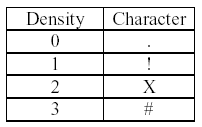

1 2 0 1 1 1 2 1 0 -1 -1 -1 -2 -2 -3 -3 -3 -3 3 0 0 0 0 0 0 0 0 0 0 0 0 0 0 0 0 0 0 0 0 0 0 0 0 0 0 0 0 0 0 0 0 0 0 0 0 0 0 0 0 0 0 0 0 0 0 0 0 0 0 0 0 0 0 0 0 0 0 0 0 0 0 0 0 0 0 0 0 0 0 0 0 0 0 0 0 0 0 0 0 0 0 0 0 0 0 0 0 0 0 0 0 0 0 0 0 0 0 0 0 0 0 0 0 0 0 0 0 0 0 0 0 0 0 0 0 0 0 0 0 0 0 0 0 0 0 0 0 0 0 0 0 0 0 0 0 0 0 0 0 0 0 0 0 0 0 0 0 0 0 0 0 0 0 0 0 0 0 0 0 0 0 0 0 0 0 0 0 0 0 0 0 0 0 0 0 0 0 0 0 0 0 0 0 0 0 0 0 3 0 0 0 0 0 0 0 0 0 0 0 0 0 0 0 0 0 0 0 0 0 0 0 0 0 0 0 0 0 0 0 0 0 0 0 0 0 0 0 0 0 0 0 0 0 0 0 0 0 0 0 0 0 0 0 0 0 0 0 0 0 0 0 0 0 0 0 0 0 0 0 0 0 0 0 0 0 0 0 0 0 0 0 0 0 0 0 0 0 0 0 0 0 0 0 0 0 0 0 0 0 0 0 0 0 0 0 0 0 0 0 0 0 0 0 0 0 0 0 0 0 0 0 0 0 0 0 0 0 0 0 0 0 0 0 0 0 0 0 0 0 0 0 0 0 0 0 0 0 0 0 0 0 0 0 0 0 0 0 0 0 0 0 0 0 0 0 0 0 0 0 0 0 0 0 0 0 0 0 0 0 0 0 0 0 0 0 0 0 0 0 0 0 0 0 0 0 0 0 0 0 0 0 0 0 0 0 0 0 0
##!................. #!.................. !................... .................... .................... .................... .................... .........!.......... ........!#!......... .......!#X#!........ ........!#!......... .........!.......... .................... .................... .................... .................... .................... .................... .................... ....................
#include <stdio.h>
int arr[22][22], temp[22][22], d[17];
char sign[] = {‘.‘, ‘!‘, ‘X‘, ‘#‘};
int main(){
int t, n, k;
scanf("%d", &t);
while(t--){
scanf("%d", &n);
for(int i = 0; i < 16; ++i)
scanf("%d", &d[i]);
for(int i = 1; i < 21; ++i)
for(int j = 1; j < 21; ++j)
scanf("%d", &arr[i][j]);
while(n--){
for(int i = 1; i < 21; ++i)
for(int j = 1; j < 21; ++j){
k = arr[i][j] + arr[i][j+1] +
arr[i][j-1] + arr[i-1][j] + arr[i+1][j];
temp[i][j] = arr[i][j] + d[k];
if(temp[i][j] < 0) temp[i][j] = 0;
else if(temp[i][j] > 3) temp[i][j] = 3;
}
for(int i = 1; i < 21; ++i)
for(int j = 1; j < 21; ++j) arr[i][j] = temp[i][j];
}
for(int i = 1; i < 21; ++i){
for(int j = 1; j < 21; ++j)
putchar(sign[arr[i][j]]);
putchar(‘\n‘);
}
if(t) putchar(‘\n‘);
}
return 0;
}HDOJ1057 A New Growth Industry 【模拟】,布布扣,bubuko.com
HDOJ1057 A New Growth Industry 【模拟】
原文:http://blog.csdn.net/chang_mu/article/details/25659131